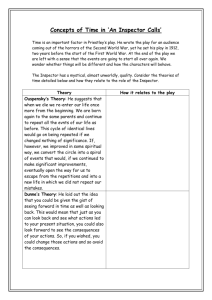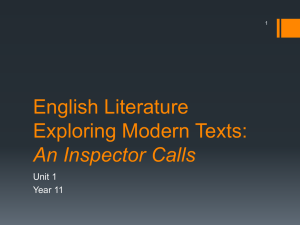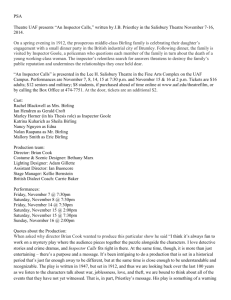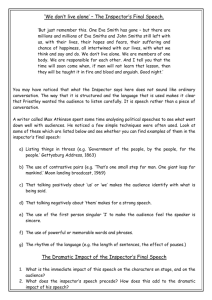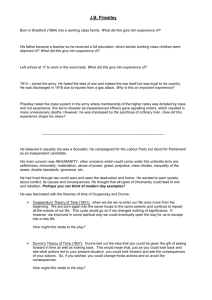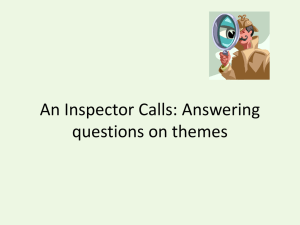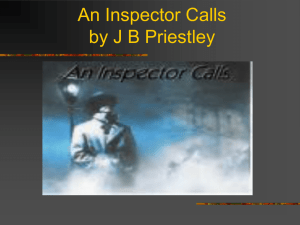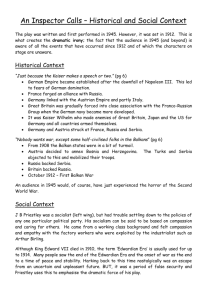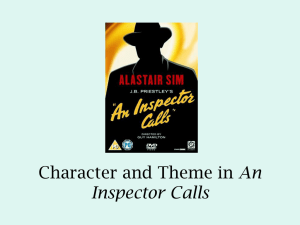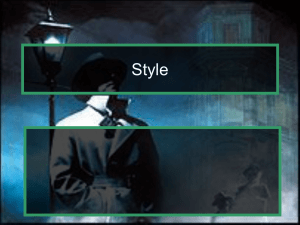gcse coursework essay on `an inspector calls`
advertisement
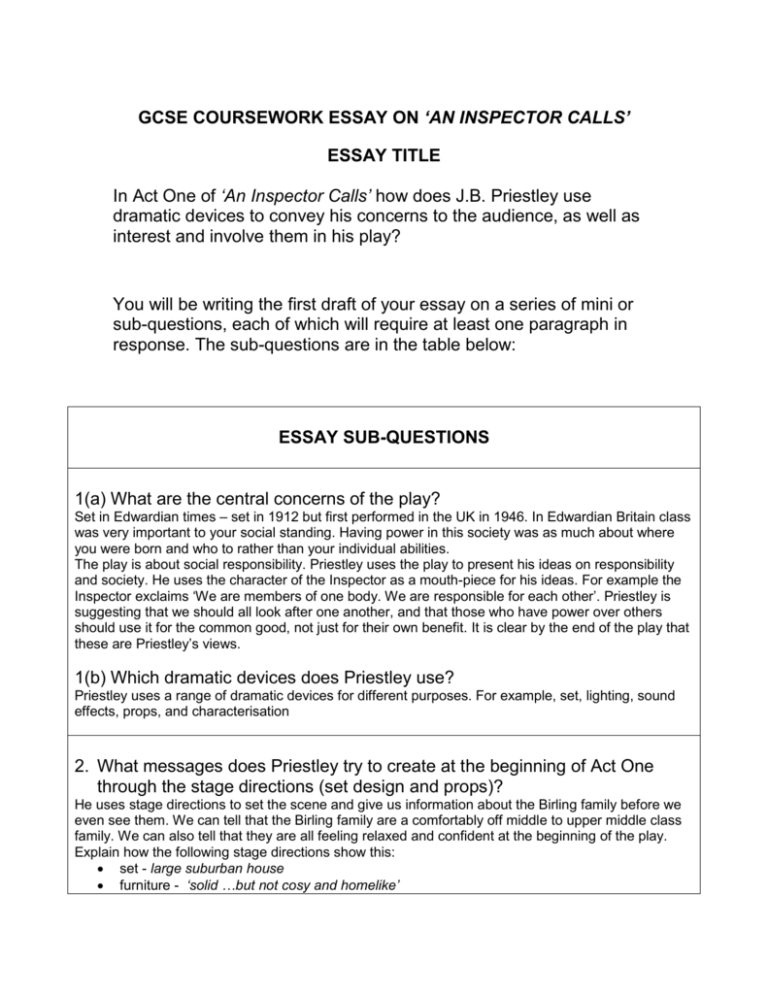
GCSE COURSEWORK ESSAY ON ‘AN INSPECTOR CALLS’ ESSAY TITLE In Act One of ‘An Inspector Calls’ how does J.B. Priestley use dramatic devices to convey his concerns to the audience, as well as interest and involve them in his play? You will be writing the first draft of your essay on a series of mini or sub-questions, each of which will require at least one paragraph in response. The sub-questions are in the table below: ESSAY SUB-QUESTIONS 1(a) What are the central concerns of the play? Set in Edwardian times – set in 1912 but first performed in the UK in 1946. In Edwardian Britain class was very important to your social standing. Having power in this society was as much about where you were born and who to rather than your individual abilities. The play is about social responsibility. Priestley uses the play to present his ideas on responsibility and society. He uses the character of the Inspector as a mouth-piece for his ideas. For example the Inspector exclaims ‘We are members of one body. We are responsible for each other’. Priestley is suggesting that we should all look after one another, and that those who have power over others should use it for the common good, not just for their own benefit. It is clear by the end of the play that these are Priestley’s views. 1(b) Which dramatic devices does Priestley use? Priestley uses a range of dramatic devices for different purposes. For example, set, lighting, sound effects, props, and characterisation 2. What messages does Priestley try to create at the beginning of Act One through the stage directions (set design and props)? He uses stage directions to set the scene and give us information about the Birling family before we even see them. We can tell that the Birling family are a comfortably off middle to upper middle class family. We can also tell that they are all feeling relaxed and confident at the beginning of the play. Explain how the following stage directions show this: set - large suburban house furniture - ‘solid …but not cosy and homelike’ props – suggests wealth ‘champagne glasses’, ‘decanter of port’ costume ‘evening dress of the period’ white tie and tails – a formal occasion lighting – ‘pink and intimate’ characters and how they are described by Priestley 3. What are the audience’s first impressions of the characters? It appears to be a very jovial evening but there is some tension in reactions to Eric. The marriage is desirable to both families from a financial point of view. However, it is significant that the Crofts are not present. 4. How does Priestley use dramatic irony in Act One? Explain dramatic irony (when an audience knows more about the characters/action than the characters on stage). Priestley uses dramatic irony to show how ridiculous and wrong Birling’s opinions are: e.g. – 1) Birling says war won’t happen ‘I say there isn’t a chance of war’ but audience knows there were two World Wars about to happen 2) Birling says that the Titanic won’t sink – we know it did 3) Birling thinks there’ll be no tension between employers and employees ‘you’ll be living in a world that will have forgotten all these Capital versus Labour agitations’ but there were strikes in1907-1912 because of poor conditions and the General Strike of 1926 The dramatic irony makes the audience think Birling is foolish and lacking in knowledge about the future. Priestley is showing an audience his concern that such idiotic people have some degree of power in this society. 5. Which techniques does Priestley use to signal the entrance of the inspector and how does this affect the audience? There’s A ‘sharp ring of a front door bell’ and Edna interrupts Birling in the middle of his speeches. The ‘sharp’ ring would startle the audience – and suggests that the Inspector may be a ‘sharp’ (as in intelligent and possibly aggressive) person. The ring also interrupts Birling suggesting that the Inspector will have power and control over Birling. There is a change of lighting from pink and intimate’ to ‘brighter and harder’ when the inspector arrives. This suggests again that the Inspector is a ‘hard’ character who will wreck the cosy world the Birlings live in. His name ‘Inspector Goole’ also suggests something unpleasant/interesting about the inspector – e.g. ‘ghoul’ means ghost 6. How does Priestley use the inspector to develop the action and build towards the climax at the end of Act One? The inspector ‘creates at once an impression of massiveness, solidity and purposefulness’. He also speaks ‘carefully, weightily’ and ‘has a disconcerting habit of looking hard at the person he addresses before actually speaking’ This interests an audience – we want to know why he is there and how people will react to his questioning. The Inspector ‘inspects’ or interrogates each person in turn. He shows a photo of Eva Smith to each character in turn that only they see. The audience is intrigued and wants to know what this is. Describe how each character reacts to the interrogation and how the audience react. Interrogation of Birling. Birling feels uncomfortable and tries to threaten Goole with his friendship with Colonel Roberts. Audience think Birling is selfish and arrogant. Beginnings of conflict between younger generation (Sheila) and older generation (Birling). Sheila responds much more instinctively and emotionally to the report of Eva Smith’s death. Audience feel some sympathy for Sheila. Inspector leaves the room, having introduced Eva Smith’s change of name to Daisy Renton. Audience want to know why this has occurred. Look at the final exchange between Sheila and Gerald. In a sense. Sheila begins the inspector’s task. The fact that the audience knows that Gerald is involved (the third out of five characters) suggests to the audience that the momentum will continue and that all the characters will be involved. The inspector returns at the end of the scene and asks his question ‘Well?’ This is a cliff-hanger – audience want to watch on to see how Gerald and Sheila react. 7. What effects have the dramatic devices achieved by the end of Act One? A great deal of tension has been created for the audience and they have the desire to know how all the characters were involved. By having a break at this point between Acts One and Two and creating a dramatic pause Priestley gives the audience some respite from all the action and creates tension for the rest of the play. Priestley has already suggested to the audience some of the themes that he develops later in his play: e.g. the idea that those in power are often undeserving of that power and foolish (as shown in his presentation of Birling in particular) and that the younger generation are more open to positive change (as in his presentation of Sheila’s remorse). Most importantly he has suggested that the Inspector is going to be the character to question the arrogant self-confidence that the Birlings have, just as he as a playwright confronts his audience’s own prejudices about power in society.
